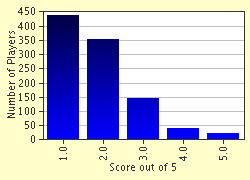Quiz Answer Key and Fun Facts
1. How many instances of the letter 'F' appear in the following text: 'FIRST AND FOREMOST, THE PHENOMENON IS A RESULT OF THOUSANDS OF TINY PARTICLES INTERACTING WITH THE SURFACE LAYER OF THE APPARATUS.'
2. We are next-door neighbors. We each own four fish: I own a male goldfish, a female goldfish, a male loach and a female loach, and you also own a male goldfish, a female goldfish, a male loach and a female loach. We are worried about our fish, so we ask the fish-doctor to come and examine them. He tells me that one of my fish is sick. Then, because you aren't home, he tells me his diagnosis of your fish. When you get home, I tell you (truthfully if annoyingly) the following: 'One of my fish is sick. Your fish are sick if they match my sick fish in EITHER gender or species, but not both gender and species. If a fish is not sick it is healthy. I'm not going to tell you which one of my fish is sick, but I will tell you that YOUR male goldfish is sick.' What can you tell about the health of the rest of your fish?
3. There is a city which hosts two taxi-cab companies, the Blue Cab Co. and the Green Cab Co. Blue cabs are blue and Green cabs are green; they are otherwise identical. 70 percent of the cabs in the city are Blue cabs, and 30 percent of the cabs in the city are Green cabs. Moreover, historically speaking, Blue cabs have been involved in 70% of all traffic accidents in the city that involved cabs, and Green cabs have been involved in 30% of all traffic accidents in the city that involved cabs. One night, there is a traffic accident involving a taxi-cab in the city, to which there is one witness. Authorities perform extensive tests on the witness, and determine that his ability to recognize cabs by their color at night is approximately 80 percent accurate and 20 percent inaccurate (meaning that when he is wrong he does not say he doesn't know, but rather misidentifies it as being of the other color). The witness says the taxi-cab involved in the accident was 'blue.' On these facts, and strictly assuming the taxi-cab was not from some other city, what is the approximate probability that the taxi-cab involved in the accident belonged to the Blue Cab Co.?
4. You agree to play a game. The dealer will deal out three cards face down. You know in advance that the three cards are an Ace and two Deuces. You will win an erotic massage from your choice of either Jennifer Lopez or Brad Pitt if you end up with the Ace, and nothing if you end up with a Deuce. First, you will select one of the three face-down cards, but you will not be permitted to look at its front-side. Then, the dealer will look at the front-sides of the two unselected cards, and will turn one Deuce face-up, leaving two face-down cards, one selected by you and one not selected by you. Finally, you will be given the opportunity, at your option, either to keep your original card or to switch it with the dealer's remaining face-down card. When the moment comes, which should you do (hint: for purposes of this question, assume you want the massage)?
5. I have a deck of cards. On every card, one side has a number and the other side has a letter. I put four cards on the table; on the sides you can see, the following cards are showing: A, Z, 5, 8. I then claim (but I may be lying) that the cards obey the following rule (the 'Rule'): 'If a card has a vowel on the letter-side, it will have an even number on the number-side.' (The Rule has no other provisions.) What card or cards would you need to turn over in order to determine whether the Rule is being violated?
Source: Author
xaosdog
This quiz was reviewed by FunTrivia editor
spanishliz before going online.
Any errors found in FunTrivia content are routinely corrected through our feedback system.


